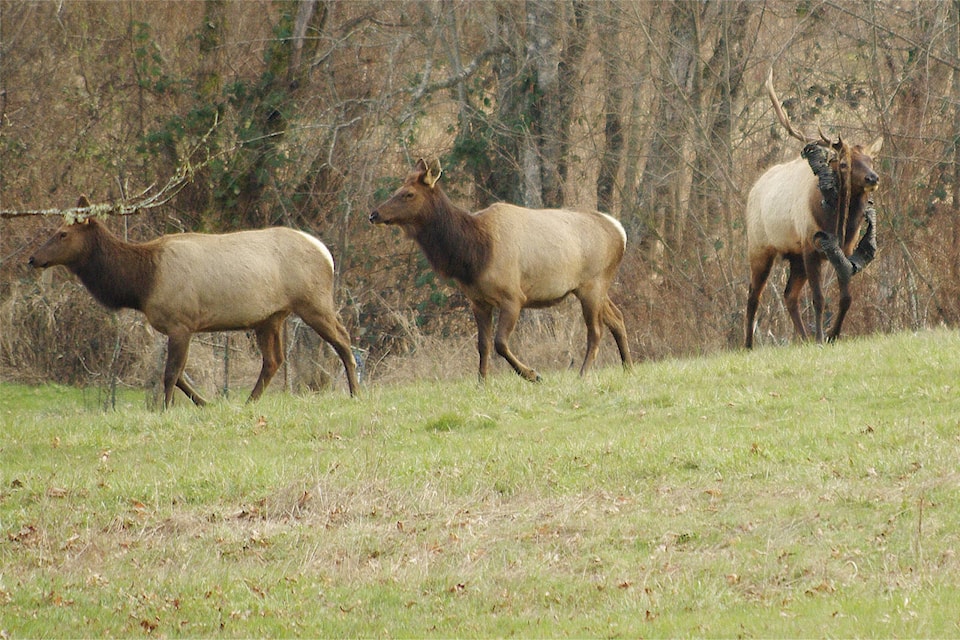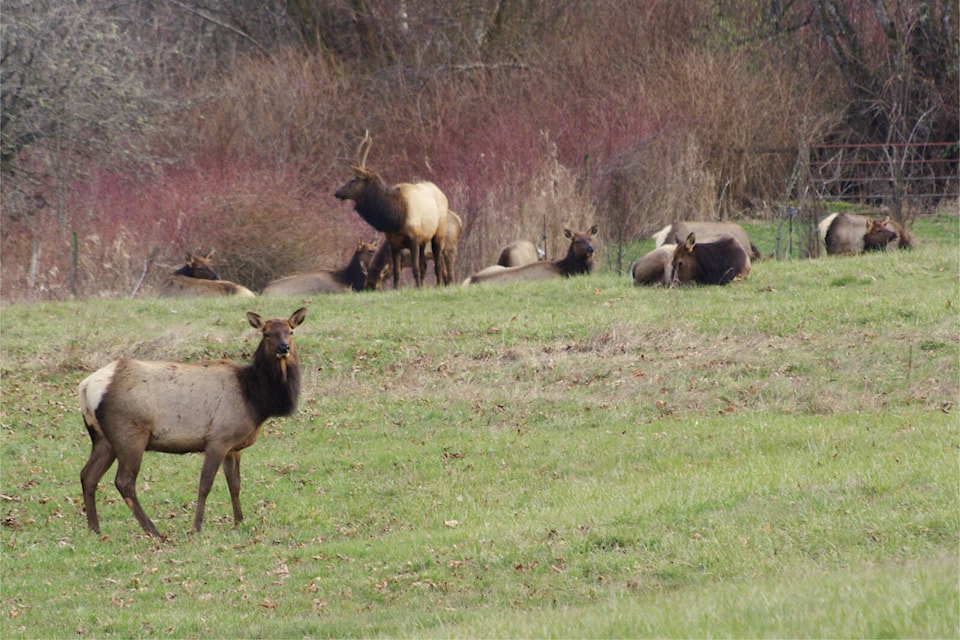Farm owners in Yellow Point and North Oyster are becoming frustrated with a herd of Roosevelt elk that have made themselves at home in the area’s hay fields.
Some fields that the elk favour belong to Carolyn and Doug Hoare, who run a seasonal farm stand and gift shop at the end of Prospect Drive.
The herd of more than 30 animals, which includes a bull elk with remnants of plastic drain pipe dangling from an antler, arrived in mid February, Carolyn said. At first the elk would come and go, but now they stay in the fields between Prospect Drive and Doole Road and no longer fear loud noises or vehicles.
“We have tried a big cow bell – they just look now,” she said. “They are also getting closer and closer to the house each day.”
The morning of March 7, several animals became separated as they roamed between fields and in their desperation to rejoin the herd, risked damaging the farm’s berry patch. It required some yelling and running around by Carolyn to get the animals redirected.
“Half were on the other side of our primary growing area where we grow our berries,” she said. “To get back to the rest of the herd, they were trying to jump into the berries area. A lot of me becoming a crazy mad farmer, running around in gumboots and pyjamas, and they did circle back down.”
Friends were unable to leave the property after a visit one afternoon when the herd blocked the driveway. Carolyn had to provide an escort in her vehicle, revving the engine and blowing the horn to clear a path.
For some area residents, the elk are becoming a costly nuisance. Gord Wyndlow has 26 hectares of hay fields on his family’s farm on Doole Road and hays a total of about 120ha of fields on neighbouring properties.
“They’re rutting the fields up and they’re laying down, which isn’t a big deal … at this time of year, but as the year goes on and my grass gets three feet high? I know my brother-in-law George, over on Takala [Road], his crop has gone down over 50 per cent,” Wyndlow said.
He said the potential loss in areas he harvests could total $50,000. The elk caused about $3,000 in lost revenue when they poked holes through plastic wrapping of 27 hay bales, causing the hay to rot.
“It’s not huge, but us farmers need every last dime and then the customer loses the much-needed feed that is already in short supply on this Island,” he said. “They’ve been right in my driveway, right by my travel trailer, they’ve stripped off cherry trees, they’ve stripped off plum trees and they get their antlers in the ground and muss up the ground.”
Wyndlow said the herd started from five animals that came over Woodley Ridge from hay fields they frequented for several years near the Trans-Canada Highway. Because the animals are a protected species, there’s little that can be done to drive them off.
“It’s very frustrating, especially since you can’t do anything, and now you’ve got to start taking up irrigation pipe and putting it up off the ground so these stupid things don’t come and walk all over them and crush them and each piece of pipe there, it’s 500 bucks,” Wyndlow said.
He has also noticed that the animals don’t seem to fear vehicles.
“They all just literally ran directly in front of me. I came up with my truck … I did blow my horn and, they just stop and stare at you, like, ‘what do you want?’” he said.
Wyndlow said he believes the herd no longer moves back up into the mountains west of the highway in the summer, but stays in North Oyster, Yellow Point and Cedar, where hay fields offer a ready supply of food and they are protected from hunters and predators.
The B.C. Ministry of Water, Land and Resource Stewardship provided a statement, acknowledging that elk can cause concern. The statement went on to say conservation officers had reviewed and assessed recent reports of elk activity in the area and that the elk had not exhibited any aggressive behaviour.
“As this is not a public safety issue, conservation officers have referred the matter to wildlife biologists,” the ministry stated.
The conservation officer service encourages residents and farm owners to consider proactive steps such as fencing to help deter elk and other wildlife from being comfortable on their properties and help mitigate wildlife conflicts.
The ministry advised contacting conservation foundation WildSafe B.C. for more information and said conservation officers will continue to monitor reports and respond as necessary to ensure public safety.
There might not be much that can be done to nudge the elk along, but farmers who suffer damage and losses can receive compensation through the province’s agriculture wildlife program. Tyler Morhart, program manager, said there are a “significant number” of Vancouver Island clients already on the program.
Applicants must have farm status, losses of more than $1,000 and meet a few other eligibility criteria.
“We can try and provide support because we’ve been getting quite a bit of reports and we’ve got lots of people in the program [due to] the elk,” Morhart said.
To learn more, visit the agriculture wildlife program website.
READ ALSO: Investigation begins after 3 dead elk found in Cowichan Lake

